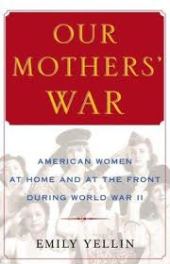In a way, I feel very lucky to have read Our Mothers’ War. The only women I’ve had significant contact with who lived through World War II (i.e., my husband’s and my grandmothers) haven’t exactly been the most willing to talk about that time of their lives. This is most likely because three of them were teenagers; the only one who was of age is my husband’s mother’s mother. The most I’ve been able to hear of her experiences of that time came when my husband’s cousin was asking questions of a genealogical nature. Because of this, I looked forward to gaining some insight into the lives of women during those times.
The first, and longest, section of the book was about the women left behind by a soldier in their life — whether it be a son, brother, husband, or boyfriend. It discussed the sacrifices made at home to make life less horrible for the soldiers. It also quoted from a lot of the letters passed back and forth between women at home and their men at the front, which I thought was pretty sweet. My only quibble with this part of the book was that there was little mention of men who got “Dear John” letters, or of men who had someone waiting at home who brought another love home from the war. I would have liked to learn a little more about that portion of life for the Greatest Generation.
The next couple of sections worked well together. They were about women who worked during the war and about women who served in the armed forces. The part that struck me the most was about the women who served in the WAACs, the WAVES, and the other women’s military groups. Not only were they faced with resentment over the type of work the majority of them were taking (secretarial and administrative work), which caused men who held those jobs to go to the front, but they faced unfair and false rumors about their behavior.
The most egregious example of this discrimination was an article published in a newspaper at the time that women going into the armed forces had sexual education training and were given condoms. The rumor was false; women working for the military were given no such education and were not given any sort of birth control. In fact, Yellin tells us, the rate of STDs among these women was almost zero, and the pregnancy rate was much lower than that of the women back home. The vast majority of the pregnancies that happened were the result of husbands and wives serving near each other. Yet these women faced comments from servicemen and Americans at home such as, “women who are serving, I have no use for them. They’re all prostitutes, in my opinion”. I can’t imagine what it’s like to be considered a prostitute for wanting to serve your country.
The last sections of the book talk about smaller groups of women in America and discusses the problems they faced (or, in one case, the problems they caused). African-American, Japanese-American, and Jewish-American women faced significant discrimination at home for wanting to help the war effort, or even to just be left alone. There were also Fascist women here who formed groups to push the prevention of intervention in the war on the European continent.
While I got a lot of interesting information and learned a lot, I did have two problems with Our Mothers’ War. The first problem is that the author kept her own opinions about the majority of the groups of women out of her writing until she gets to parts about “undesirable” women, such as prostitutes who worked in Hawaii. She then pushes a certain type of feminism that doesn’t happen to be mine, and it drove me nuts. I didn’t feel that I needed to be preached to while I was learning about the conditions these women lived in.
My other problem with Yellin is in the other direction. She presents primary sources to give us information, but she fails to create a story about women during WWII. The vast majority of her writing would be better suited to an academic summary of the topic, not a book intended for popular consumption. It would have been nice to read something that was a little more narative.
Our Mothers’ War provides good information. It just would be nice for it to be better suited to the intended audience.
Rating: 3.5/5






